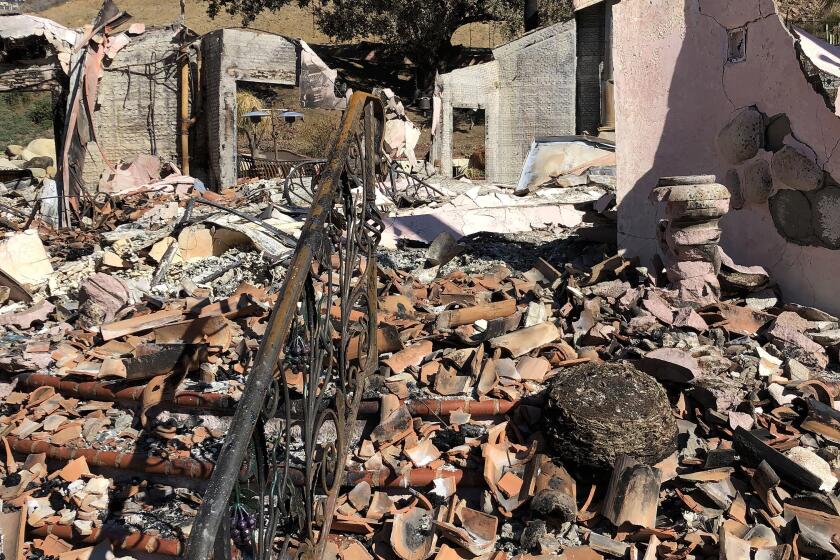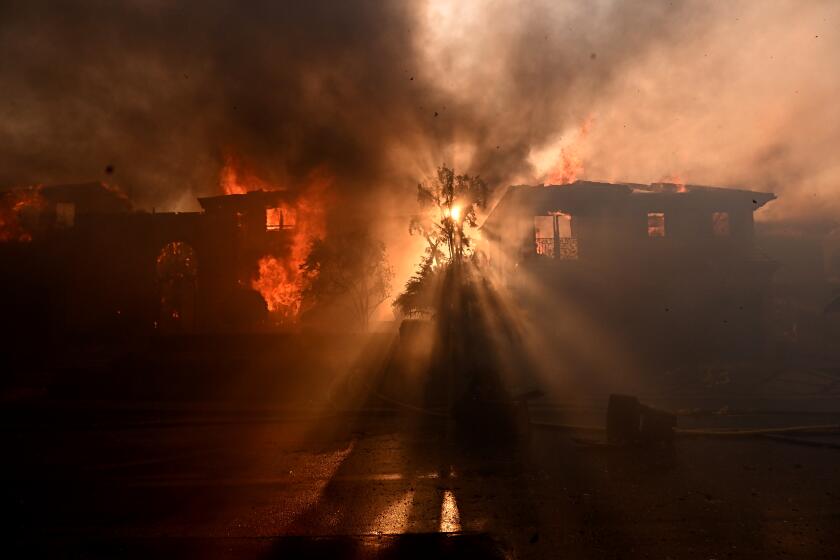Hellish fires, low pay, trauma: California’s Forest Service firefighters face a morale crisis

Chris Mariano became a federal wildland firefighter because he wanted to help protect the Northern California landscapes and communities he’d grown to love.
Years later, after working his way up to squad boss of the elite Truckee hotshot crew for the U.S. Forest Service, Mariano resigned in a viral letter that is the latest example of how low pay, grueling work and mental stress are driving experienced professionals out the door at a time when extreme wildfires are becoming more destructive.
“It almost feels as though we’re out there doing the very best we can, but it’s not enough,” Mariano said. “And that’s tough, to know that you’re giving everything you have, and communities are still being lost.”
Morale within the Forest Service has plummeted to an all-time low, current and former firefighters say.
The work is backbreaking physical labor that pays an average starting wage of $15 an hour, not including hazard pay and overtime. Raises promised in last year’s infrastructure bill remain in limbo. Low wages have combined with skyrocketing housing costs to ensure that many firefighters can’t afford to live in the places they work.
The conditions have left the Forest Service struggling to recruit and retain employees.
The resignation letter from former U.S. Forest Service firefighter Chris Mariano.
Officials recently announced that they were unable to fill about 1,000 temporary firefighter positions and looking to make emergency hires by shortening the onboarding process.
As California faces what is expected to be a punishing fire season, only 62% of federal firefighter positions here are filled, according to a source within the agency. Before 2020, nearly all spots nationwide typically would be filled at this time of year, said the source, who requested anonymity to discuss sensitive internal matters.

In addition, roughly a third of all Forest Service fire engines in California are on five-day staffing, meaning there aren’t enough crew members to operate them seven days a week. An additional 13% of engines are “down staffed” — essentially parked because of a lack of firefighters, the source said.
The Forest Service has acknowledged challenges in reaching this year’s national target of 11,300 firefighters, especially in the Pacific Northwest and Southwest regions, which include Oregon, Washington and California.
The recruitment and retention problems are in areas “where state and private firefighter wages are outcompeting federal firefighter wages, housing costs are not affordable, and positions are in remote locations,” the agency said in a statement.
The Forest Service is able to order up emergency personnel — generally retired agency employees who can support incident-management teams and other firefighting duties — and said it is working to bring on more contractors to help.
Riva Duncan, who was a wildland firefighter for 31 years before retiring in December 2020, is troubled.
“The information we’re seeing for ourselves and hearing from our folks on the ground is painting a pretty dire picture,” said Duncan, now executive secretary of the advocacy group Grassroots Wildland Firefighters, adding that some hotshot crews are struggling to maintain their qualification status.
Efforts are underway to rebuild Greenville, Calif., from the ashes of the Dixie fire. Can it be made to survive the next wildfire?
Some longtime firefighters say the problem is a direct consequence of low pay.
The California Department of Forestry and Fire Protection and some other state and municipal agencies can pay starting salaries that are twice as much and typically compensate firefighters for 24-hour shifts while on assignment. Federally employed firefighters are generally paid for only up to 16 hours a day, Duncan said.
Jesus Munoz, 20, recently left the agency after just a month and a half of working on an engine in the Lassen National Forest. He was commuting 130 miles from Nevada to stay during the week at barracks that were often infested with bugs, rodents and squirrels, he said. The rent on his home and the barracks — it costs firefighters to stay there while on duty — plus gas and groceries, consumed virtually all of his $15-an-hour salary.
“It was almost to the point where my paychecks, as soon as I got them, they were gone,” he said. “We’re getting paid $15 an hour to put our lives on the line.”

Forest Service firefighters typically are classified as forestry technicians and currently start at an annual base salary of $24,749 to $32,174. President Biden’s bipartisan infrastructure bill signed into law in November directed officials to create a federal wildland firefighter job classification and to increase the salary by the lesser of $20,000 or 50%, provided officials determine the job is located in an area where it is difficult to recruit or retain personnel.
But more than six months later, no raises have been doled out and it’s unclear when they will take effect or to whom they will apply. The Forest Service says it hopes to get the money into paychecks this summer.
“It’s frustrating that there are still so many unknowns,” Duncan said.
Some water districts say new drought restrictions raise wildfire risks. They are demanding that the state give them more water for outdoor irrigation.
Pay is not the only problem. Physical and mental trauma and extended periods away from home are causing an increasing number of firefighters to call it quits. Assignments often last 14 to 21 days, with three days off in between — a particularly difficult schedule for those who have a family or are trying to start one, firefighters say.
Many of those fleeing are mid-career professionals whose expertise is needed to run engine and hand crews.
“It’s that institutional knowledge that is leaving the Forest Service,” said Jonathon Golden, 40, who resigned in 2019 after more than 10 years. “Yeah, we’re losing a workforce, but the Forest Service is also going through a brain drain of how to successfully suppress fire in complex environments.” Those environments increasingly involve the wildland-urban interface, where fire poses the most risk to lives and property, he said.
A permanent seasonal worker, Golden said he’d “beat himself up” to get 1,000 hours of overtime each season to sustain himself through the months he wasn’t working. Still, he said, it’s not enough to cover his federal health coverage premiums year-round, so he incurs debt.
“It was kind of like this weird thing where you were finding yourself hoping for overtime, hoping for fire so you could pay this debt back faster or have more money coming in,” he said. “But also at the same time, that was taking you away from home.” Golden’s first son was born in 2017; that Christmas, his son’s first, Golden was working a fire near Ojai, he said.
Finding a place to call home was also a challenge. Federal firefighters receive no housing stipend. In some areas, the Forest Service provides barracks, but the rents are pegged to market rates, Golden said.
“There are very few places where I worked where housing was available, and even if it was available, the conditions were questionable,” he said.
Mental health issues have also become an increasing problem as fires have grown more dangerous and damaging.
In a recent survey of more than 700 current and former wildland firefighters conducted by a Forest Service firefighter and advocate, 78.5% of respondents reported mental health issues they attributed to the stresses of fighting fires, while just 32.3% said they felt they had the time and resources to seek help.
“Considering the multitude of stressors that [wildland firefighters] must face while serving their communities, it’s unsurprising that mental health is a major point of concern,” wrote survey author Rachel Granberg, who sought to identify barriers to recruiting and retainment. “Ample anecdotal evidence suggests that substance abuse, depression, anxiety, bipolarity, and death by suicide are rampant among the ranks.”
One in five California Airbnb short-term rental properties are in wildfire-prone areas, yet the company provides no warnings or evacuation information.
One service employee — an assistant engine operator who spoke with The Times on the condition of anonymity because he feared retaliation — said he was considering retiring after this year, due to low pay and trauma.
“If this money from the infrastructure bill doesn’t come through, more people are leaving,” he said. “Everybody at my station including the captain is just holding on to see if they might get a raise.”
He was forced to take an unauthorized second job in order to support his family, he said, resulting in 80-hour workweeks.
And the perilous work, which has included close calls and the deaths of co-workers, has taken a toll on his mental health, he said; after suffering persistent blackouts, he was diagnosed with PTSD.
“I literally had gone to a place where I was driving the crew rig with the guys to a fire and then waking up down the highway still driving,” he said. After finding he was unable to get timely help through the agency’s Employee Assistance Program, he decided to find his own therapist and pay out of pocket, he said.
“I pay almost $400 a month just to not want to kill myself, and I’m probably going to stop paying that because I can’t afford it — not on the salary they’re paying us,” he said.
For Munoz, the decision to quit came after he suffered a shoulder injury during physical training. He encountered long waits when trying to receive treatment through the workers’ compensation program and still hasn’t been able to book an appointment with a specialist.
His longer-serving colleagues advised him to look for work elsewhere, he said.
“Even some of the hotshots, some of the best of the best, when I was talking to them about moving on from the agency, they were telling me: If you can get out young, do it,” he said.
“For the most part, everyone seemed like they were miserable when it came to their physical and mental health,” he added.
Severe drought, gusty winds and sloping topography were a devastating combination for this seaside housing development in Laguna Niguel.
The hardships experienced by wildland firefighters are also borne by their families.
Michelle Hart, 36, the wife of a Forest Service smokejumper — a firefighter who parachutes into wildfire zones — recalled the stress of being unable to reach her husband for weeks at a time when he worked in remote areas. She lived in constant fear that she’d get a call from an unknown number bearing bad news.

That call finally came last May. Her husband, Tim, had suffered mortal injuries in a hard parachute landing at a New Mexico wildfire.
As he lay in a hospital bed, Michelle promised that she would do everything she could to make his life and his death matter.
“To have lived through such a hard time of being away from someone, knowing he slept in his truck, went through horrible conditions, then ended up dying for this job — it felt like there was a lot of injustice there,” she said.
In the aftermath, Michelle worked with Golden and other Grassroots Wildland Firefighters volunteers to develop a list of needed reforms, then met with dozens of legislators to push for them.
The result — The Tim Hart Wildland Firefighter Classification and Pay Parity Act — is currently before the U.S. House, and would establish a new pay scale that starts at $20 an hour, housing stipends and other forms of compensation. It would also put in place a more robust mental health program and require presumptive healthcare for diseases including heart and lung disease and certain cancers. Right now, unlike most state and municipal firefighting departments, federal firefighters must prove these diseases were caused by their employment.
FEMA is often seen providing aid victims of hurricanes and tornadoes, but Caldor fire survivors say the agency has done little for them.
In his widely shared resignation letter, Mariano said the issues federal firefighters are struggling with today are the same ones they have struggled with for decades. What has changed are the conditions they work in.
“The wildfire environment has changed and agency leadership has failed to acknowledge these new risks, responsibilities, liabilities and the burdens placed on their employees,” he wrote. “As a result, we are facing a dire retention issue.”
He blamed the drive for “political success” and lack of modern wildland firefighting experience among agency leaders as a root cause of the problem.
In an interview with The Times, Mariano said he felt compelled to speak out to make the public aware of the issues so they can lean on legislators and effect change.
“You give everything on the line every day, and we ask individuals to go above and beyond every single day and to work in dangerous environments with potential long-term health effects, and they can’t afford to buy houses or live comfortably,” he said. “It’s a tough pill to swallow.”
Watch L.A. Times Today at 7 p.m. on Spectrum News 1 on Channel 1 or live stream on the Spectrum News App. Palos Verdes Peninsula and Orange County viewers can watch on Cox Systems on channel 99.
More to Read
Sign up for Essential California
The most important California stories and recommendations in your inbox every morning.
You may occasionally receive promotional content from the Los Angeles Times.

















